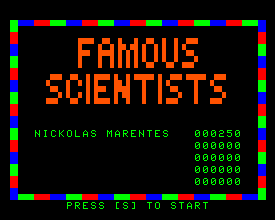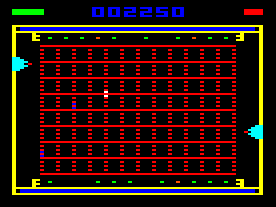I
created the original Neutroid back in March 1983. It was my
second complete assembly language game for my first computer, the
TRS-80 Model 1. Neutroid featured fast graphics, impressive sound and
frenetic action. It was a great arcade game that pushed the
capabilities of the TRS-80 Model 1. At the time, I thought I had a real
winner on my hands but as fate would have it, it didn't exactly set the
market on fire. Later
in 1984, I switched across to the Tandy Color Computer with color
and high resolution graphics. But it was not my ideal choice. There
were several other systems on the market with better graphics and sound
capabilties for much the same price. But
the Color Computer had two things in it's favour that interested me.
Firstly was the excellent Motorola 6809 CPU, clearly the leader of the
8 bit CPU's at the time. Secondly, the Color Computer had a wide
distribution network via the 700 Tandy Electronics stores across
Australia at the time. Although the Color
Computer's Motorola 6847 video chip did not impress me, these other two
factors did and I decided to take up the challenge to create software
which would push the machine's limitations to a new level. With
an idea to create a game using the underutilized 8 color semigraphics
modes, I settled on recreating Neutroid for the Color Computer and
created Neutroid 2 in October 1984. This was my first assembly language
commercial game for the Color Computer. As
before, I thought I had the ultimate killer arcade game for the Color
Computer. As before, it was a flop... an even bigger failure than
the original TRS-80 Model 1 version. I was ready to throw in the towel
but perservered and later released Donut Dilemma which went on to
become my most successful Color Computer game being sold in every Tandy
Electronics store in Australia. So
what went wrong with Neutroid 2? It had 8 color graphics, fantastic
sound and fast arcade action... all the important ingrediants required
by a blockbuster arcade game. People just didn't get it! Neutroid
was too abstract for people to understand. The atomic theme of the game
seemed to be too complex for people to comprehend. There was a
preference for games with a character or familiar scenario. Nuclear
particles moving on a grid was just too alien. It
was also a very hard game requiring rapid reflex decisions, the ability
to track several objects at a time and was too difficult to control
with the keyboard arrow keys. And another problem... There was another problem which surfaced a few years later. When
the Color Computer 3 was released in 1986, it didn't support the
semigraphics modes. Over time, it was discovered that in actual fact it
did... at least most of it. All the semigraphics modes could be
activated with the Color Computer 3's GIME with the addition of an
extra POKE. What it didn't do though was to include the ability to
display text characters (ASCII 0 - 127). Only the text
mode graphics (ASCII 128 - 255) could be displayed. Most programs
using semigraphics would display the score in text characters and this
didn't work on a Color Computer 3. Neutroid 2 was no different so
although Neutroid 2 could be made to work, the player had no idea of
his score during play and any text prompts were invisible. Although
I had moved on from Neutroid into other more familier game styles,
Neutroid's failure to capture any excitement always bothered me and I
have always felt there were some things I could have improved to make
the game more acceptable. Neutroid returns! Back
in May 2015, the thought came to me to finally resurrect Neutroid
2 and fix the areas that have been bothering me for so long. I still had the assembly language source code and all the graphic and sound media files archived on my PC hard drive. Two months later and Neutroid 2.015 is complete. Why the name 2.015? Because the update to Neutroid 2 was done in 2015! Below
is a list of changes I did to Neutroid 2. Apart from these, the code is
much the same. My goal wasn't to rewrite Neutroid 2 but to make
some improvements, adjust the gameplay to make it easier and fix
it for Color Computer 3 compatibility. 
The new title page | 
The improved high score page |
NEUTROID 2.015 updates Removal of ASCII 0-127 text and replaced with ASCII 128-256 graphics The
score display was rewritten and replaced with a semigraphics version.
Several text prompts were also removed/replaced. The game itself now
functions completely in semigraphics and compatible with all versions
of the Color Computer including the Color Computer 3. Minimum of 16K
RAM required as before. Removal of keyboard control system and replaced with joystick control system The
original Neutroid 2 used the four arrow keys for control. This was the
same as for the TRS-80 Model 1 version. The Color Computer 1 and 2
arrow keys were positioned at opposite ends of the keyboard which made
for a comfortable posture. The Color Computer 3 moved the arrow keys in
a diamond cluster and created a cramped posture which made it almost
impossible to control the Neutroid and led to much finger
entanglement... made even worst at my older age. :) I
highly recommend Tandy's deluxe self-centering joystick. The original
free-floating black joysticks are a horror to use and will drive you
into insanity. Be aware that Neutroid 2.015 is a high octane joystick destroying game. :) Graphics update The
Protroid emittors, Grid Chargers and the display bars graphics
(Vault Temperature and Neutroid Energy) have been given a slight
facelift. The display bars in particular have been made easier to read
and interprete at a glance. During the pace of the gameplay, looking at
these displays can be a distraction so they have been made easier and
clearer to read. These are critical to monitor closely as you progress
into the higher and more demanding grids. New Title Page and improved High Score page The
Title Page has been jazzed up a bit and the Famous Scientists high
score page has an improved light chaser effect. These are only cosmetic
but I always thought the originals were kinda drab. Level progression adjusted Neutroid
2 was always a hard game. I designed it for the arcade andrenalin
junkie but the level progression was too hard. I have adjusted the
progression to a setting that I am happy with. Some will still say it's
still too hard and will have difficulty getting past the first
level but that is a sign that you're not playing it right. Once you
work out a few patterns and strategies, the first two levels are
moderately easy. My
hands are not as dextrous as they were 30 years ago but now with
joystick control incorporated, I can get through 4 levels
consistently... then it starts getting insane! Improved documentation I
developed a new set of instructions to more clearly convey the game
concept. I reduced the text of the original and incorporated a
screenshot, pointing out what and where everything is. There is also a YouTube video guide on how to complete Grid 1 (see link below). |

Demonstration Video
|
Click
on the image above to see a demonstration video of how I complete
Grid 1. Grid 1 is the slowest and easiest level. You can see the
repeating pattern I use to collect the Protroids. My emphasis is in
collecting Protroids rather than avoiding Antitroids. I keep track of
how many Antitroid collisions I sustain keeping an eye on my energy
bar. When this goes too low, I collect an orange Protroid to give me a
few seconds of re-energization and chase Antitroids.
|